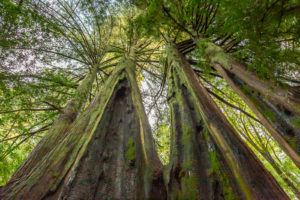Q: I just walked trails at Indian Tree Open Space in West Novato. Ship’s Mast Trail takes hikers through a magical section of very tall, slender redwoods. How did this area happen? Were the trees planted that close together, or is this a different species of redwoods? Maybe the competition for light keeps them so slender: The only way to grow is up.
– Linda, Santa Rosa
A: You’re right, Linda – “magical” is an appropriate term for that stretch of trail. The uniform size and spacing of the trees on that slope suggests that it was logged within the last century, and what we see there is a very dynamic example of competition and selection. And you’re right, the only way to grow is up; every individual is fighting for a share of the sun, but root development and access to water are probably equally important. You can already see a few of the “losers”, most of which are still vertical, but they have been shaded to death by their stronger relatives, and are standing only because they are being held up by their neighbors. There is a section of the Dipsea trail just above Steep Ravine that is similar, but the trees are older (about twice the girth of those at Indian Tree) and at least half of them have already lost out in the competition for light. I also know of a “Pygmy” coast redwood forest in Sonoma County that looks quite similar, but I understand that those trees have been dwarfed due to the hard pan restricting their root development.
The growth rate of coast redwoods is influenced by many factors, but the effects of crowding can be observed by looking at the growth rings alone. A section of a tree estimated to be about 200 years old showed that the tree only attained a diameter of 8 inches after 137 years. At that point, the trees around it were removed during selective logging. After that the tree grew to 48 inches in diameter in just 37 years; an eleven-fold increase when direct competition was eliminated.
Another nice aspect of that particular grove of trees is that after the original trees were harvested, redwoods re-populated that slope. In many similar situations, post-harvest succession gives rise to Douglas-firs which are out-competing other native vegetation in many parts of western North America. Encroachment by Douglas-fir is believed to be a consequence of several human caused factors such as fire suppression and grazing. Although it is a native species, Douglas-fir is now looked upon as a somewhat invasive species in some areas, prompting control measures in some situations.
— David Herlocker, Interpretive Naturalist, Marin County Parks





